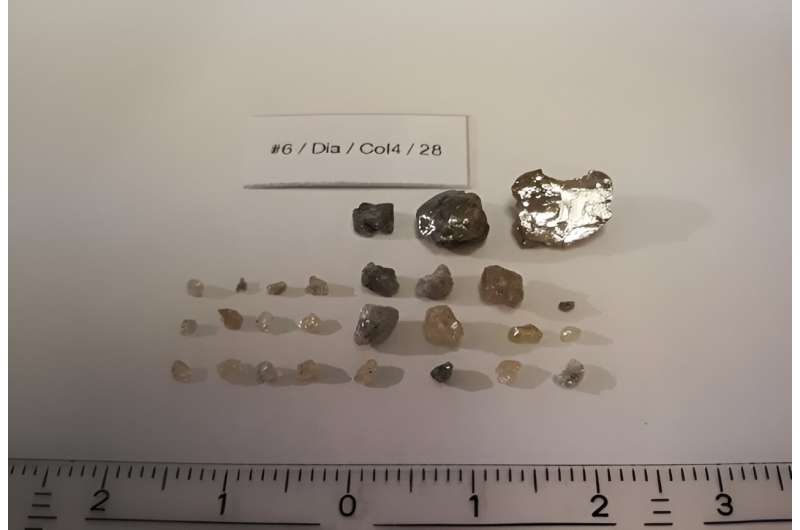This article has been reviewed according to Science X's editorial process and policies. Editors have highlighted the following attributes while ensuring the content's credibility:
fact-checked
peer-reviewed publication
trusted source
proofread
Superdeep diamonds provide a window on supercontinent growth

Diamonds contain evidence of the mantle rocks that helped buoy and grow the ancient supercontinent Gondwana from below, according to new research from a team of scientists led by Suzette Timmerman—formerly of the University of Alberta and now at the University of Bern—and including Carnegie's Steven Shirey, Michael Walter, and Andrew Steele. Their findings, published in Nature, demonstrate that superdeep diamonds can provide a window through space and time into the supercontinent growth and formation process.
For billions of years, Earth's landmasses have been ripped apart and smashed back together by plate tectonics, periodically forming giant supercontinents. This formation process results from large-scale convection of the planet's mantle. But the records of these events are poorly preserved, because the oceanic crust is young and continually sinks beneath the planet's surface by a process called subduction, while the continental crust only provides a limited view of Earth's deep workings.
Surprisingly, the research team was able to show that superdeep diamonds that formed between 300 and 700 kilometers below Earth's surface can reveal how material was added to the base of a once-mighty supercontinent.
"These diamonds allow us to see how deep plate tectonic processes relate to the supercontinent cycle," Shirey said.
The supercontinent Gondwana is thought to have formed between 800 and 550 million years ago in Neoproterozoic times. Starting over the present-day location of the South Pole, it incorporated the landmasses that make up present day South America, Africa, the Middle East, India, and Australia.
"By revealing the geological processes that contributed to Gondwana's growth, scientists can better understand the forces that shaped Earth's history and phenomenon of continental stability, which is—of course—fundamental to the eventual success of life on our planet," added Walter.
About 40 to 250 kilometers beneath the surface, geologic formations called mantle keels act as the foundation of the continental crust. The material that forms these keels thickened, stabilized, and cooled under the continental blocks to form strong, buoyant structures that can resist the relentless destructive forces of Earth's tectonic activity.
Remnants of the mantle rocks that helped form the keel can be found in tiny silicate and sulfide inclusions hidden inside these superdeep diamonds. Typically flaws in normal gem diamonds, these inclusions are the best friends of a geoscientist. They were identified, isolated, studied crystallographically, and then radiometrically dated to determine their geologic ages.
This work was carried out by researchers at the University of Alberta and the Carnegie Institution for Science, as well as by other teams of diamond specialists at the Vrije Universiteit Amsterdam, University of Bristol, and the University of Padua. It required many steps, including shipping the diamonds around the world several times, and deployed some of the most precise mass spectrometers and X-ray diffractometers available.
"The study of such rare samples with a variety of measurement techniques required major teamwork. But even more remarkable is how careful analyses of such minute amounts of material can shed light on the evolution of Earth's largest continental landmasses," Timmerman explained.
"The age of these inclusions provides a record of when buoyant mantle was added to Gondwana from below, thereby scaffolding, underpinning, and growing the supercontinent" added Shirey.
Then, about 120 million years ago, the supercontinent once buoyed by the rocks that housed these diamonds started to break up and, eventually, 30 million years later—around 90 million years ago—the diamonds—and the inclusions trapped inside them—were brought to the Earth's surface in violent volcanic eruptions of diamond-bearing kimberlite magma.
Now, by combining their lab analysis with existing models of tectonic movement and continent migration, the researchers can use these remarkably well-traveled diamonds to understand how material welds continental fragments together from below, stabilizing such a super-sized continental landmass.
More information: Suzette Timmerman et al, Sublithospheric diamond ages and the supercontinent cycle, Nature (2023). DOI: 10.1038/s41586-023-06662-9
Journal information: Nature
Provided by Carnegie Institution for Science





















